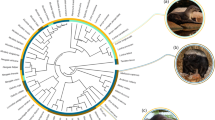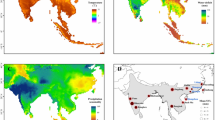Abstract
Generally rodents are found to be larger on islands than on the mainland. However, there are some exceptions to this rule, and the aim of this paper is to examine one of them. On the mainland of Senegal,Mastomys huberti occupies humid habitats. However, it occurs also on dry and sandy islands (Saloum delta), where its representatives are dwarf. Since water availability appeared to be the limiting factor in these islands when compared to the mainland, we studied water turnover characteristics in relation to body size, in mainland and island populations at the end of the dry season, under both field and laboratory conditions. All populations were found to be water balanced in their natural habitats. They presented similar rates of water turnover, even though island animals were subjected to stronger constraints than mainland ones. Laboratory experiments suggested that the physiological plasticity of one of the island populations may be reduced. Island populations have a higher kidney size to body weight ratio than those from the mainland. We propose that smaller size in the islands allows the maintenance of water balance with a smaller amount of water, and that a higher ratio of kidney filtration surface to body size may helpMastomys huberti to survive in dry islands. We discuss the factors responsible for body size variability and variation in water exchange characteristics and conclude that different factors could explain body size variation among island populations, depending on the species considered and the ecological constraints met within the islands.
Similar content being viewed by others
References
Foster, J. B., Nature202 (1964) 234.
Berry, R. J., Evolution18 (1964) 468.
Case, T. J., Ecology59 (1978) 1.
Van Valen, L., Evol. Theory1 (1973) 31.
Lawlor, T. E., Am. Nat.119 (1982) 54.
Lomolino, M. V., Am. Nat.125 (1985) 310.
Angerbjörn, A., Am. Nat.125 (1985) 304.
Granjon, L. and Duplantier, J. M., Acta Oecologia.10 (1989) 135.
Blondel, J., Biogéographie évolutive. Masson, Paris 1986.
Duplantier, J. M., and Granjon, L., Sci. Tech. Anim. Lab.13 (1988) 129.
Duplantier, J. M., Biologie évolutive des populations du genreMastomys (rongeur, muridé) au Sénégal. Doctorat d'Etat, Université Montpellier II, Montpellier 1988.
Macfarlane, W. V., and Howard, B. Symp. zool. Soc. Lond.31 (1972) 261.
Grenot, C. J., in: Le Rongeur et l'Espace, p. 39. Eds M. Le Berre and L. Le Guelte. R. Chabaud, Paris 1991.
MacMillen, R. E., and Hinds, D. S., Ecology64 (1983) 152.
Morris, K. D., and Bradshaw, S. D., Aust. J. Zool.64 (1983) 519.
Ben Chaouacha-Chekir, R., Lachiver, F., and Cheniti, T., Mammalia47 (1983) 543.
Sicard, B., Navajas Navarro, M., Jacquart, T., Lachiver, F., and Croset, H., C. r. Acad. Sc. Paris.300 (1985) 699.
Navajas, Y., and Navarro, M., Facteurs sélectifs et stochastiques de la différenciation de populations insulaires deMus musculus domesticus: analyse à divers niveaux d'integration (genome, individu, population). Thèse de Doctorat, Université Montpellier. II 1986.
Granjon, L., Evolution allopatrique chez les muridés: mécanismes écoethologiques liés au syndrome d'insularité chezMastomys etRattus. Thèse de Doctorat, Université Montpellier II, Montpellier 1987.
Nagy, K. A., and Costa, D. P., Am. J. Physiol.238 (1980) R454.
Gagnon, J., et al., Super Anova: Accessible General Linear Modelling. Abacus Concepts, Inc., Berkeley 1989.
Duplantier, J. M., Orsini, P., Thohari, M., Cassaing, J., and Croset, H., Mammalia48 (1984) 129.
Hubert, B., Mammalia46 (1977) 137.
Poulet, A. R., Biotrop. special publ.12 (1980) 123.
Anderson, P. K., Trans. N.Y. Acad. Sci.23 (1961) 447.
Christian, J. J., Science168 (1970) 84.
Zegeren K. van., Netherlands J. Zool.30 (1980) 635.
Buffenstein, R., and Jarvis, J., J. Arid Environments9 (1985) 232.
Sahni, M., Paignoux-Deville, J., and Lopez, E., Can. J. Zool.71 (1993) 651.
Richmond, C. R., Langham, W. H., and Trujillo, T. T., J. Cell Comp. Physiol.59 (1962) 45.
Hewitt, S., Comp. Biochem. Physiol.69A (1981) 297.
Author information
Authors and Affiliations
Rights and permissions
About this article
Cite this article
Ganem, G., Granjon, L., Ba, K. et al. Body size variability and water balance: A comparison between mainland and island populations ofMastomys huberti (Rodentia: Muridae) in Senegal. Experientia 51, 402–410 (1995). https://doi.org/10.1007/BF01928905
Received:
Revised:
Accepted:
Published:
Issue Date:
DOI: https://doi.org/10.1007/BF01928905




